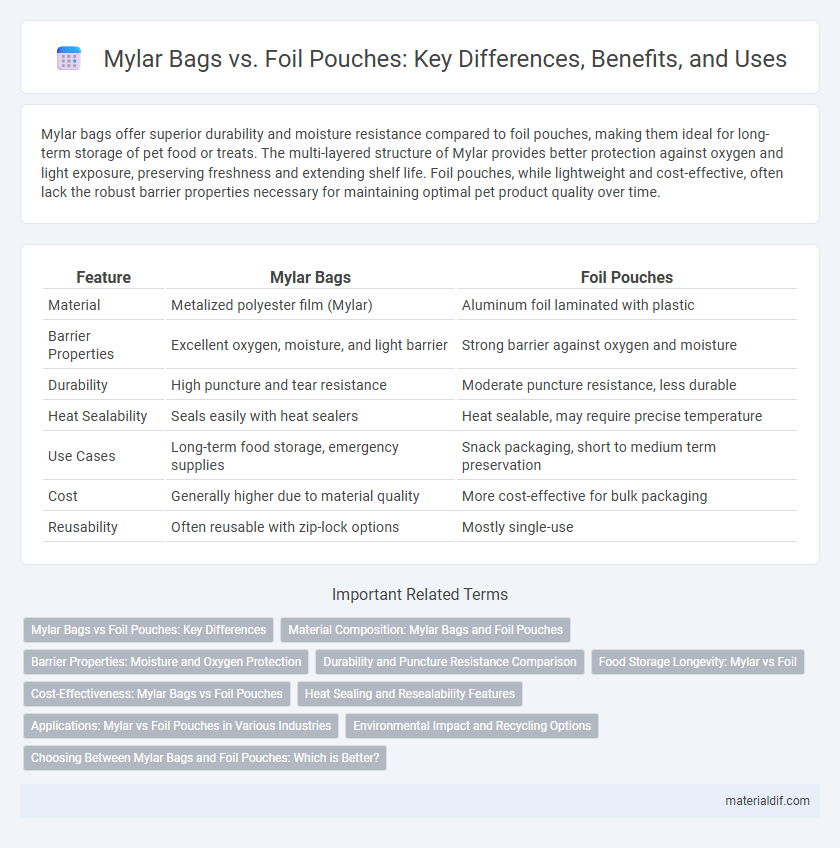Mylar bags offer superior durability and moisture resistance compared to foil pouches, making them ideal for long-term storage of pet food or treats. The multi-layered structure of Mylar provides better protection against oxygen and light exposure, preserving freshness and extending shelf life. Foil pouches, while lightweight and cost-effective, often lack the robust barrier properties necessary for maintaining optimal pet product quality over time.
Table of Comparison
| Feature | Mylar Bags | Foil Pouches |
|---|---|---|
| Material | Metalized polyester film (Mylar) | Aluminum foil laminated with plastic |
| Barrier Properties | Excellent oxygen, moisture, and light barrier | Strong barrier against oxygen and moisture |
| Durability | High puncture and tear resistance | Moderate puncture resistance, less durable |
| Heat Sealability | Seals easily with heat sealers | Heat sealable, may require precise temperature |
| Use Cases | Long-term food storage, emergency supplies | Snack packaging, short to medium term preservation |
| Cost | Generally higher due to material quality | More cost-effective for bulk packaging |
| Reusability | Often reusable with zip-lock options | Mostly single-use |
Mylar Bags vs Foil Pouches: Key Differences
Mylar bags offer superior durability and excellent moisture, oxygen, and light barrier properties compared to foil pouches, making them ideal for long-term food storage. Foil pouches are generally more flexible and cost-effective but lack the multi-layered protection provided by Mylar bags, which often include PET and aluminum layers. The key differences hinge on protection level, reusability, and resistance to punctures, with Mylar bags excelling in preserving product freshness over extended periods.
Material Composition: Mylar Bags and Foil Pouches
Mylar bags are constructed from biaxially-oriented polyethylene terephthalate (BoPET), offering superior tensile strength and moisture resistance. Foil pouches primarily contain aluminum foil laminated with plastic layers, enhancing barrier properties against oxygen and light but often lacking the structural durability of Mylar. The distinct material compositions influence each packaging type's effectiveness in preserving perishable goods and extending shelf life.
Barrier Properties: Moisture and Oxygen Protection
Mylar bags provide superior moisture and oxygen barrier properties compared to standard foil pouches, ensuring prolonged freshness and protection for sensitive products. Their metalized polyester film structure offers low permeability to water vapor and oxygen, which is critical for preserving food, pharmaceuticals, and electronics. Foil pouches, while effective, typically have higher moisture and oxygen transmission rates, making Mylar bags the preferred choice for long-term storage and preservation.
Durability and Puncture Resistance Comparison
Mylar bags exhibit superior durability compared to foil pouches due to their multi-layer polyester and aluminum structure, which provides enhanced resistance to tearing and environmental factors. Their puncture resistance is significantly higher, as Mylar materials can withstand sharp objects and rough handling better than the thinner, less flexible foil pouches. This makes Mylar bags ideal for long-term storage of food and sensitive items requiring robust protection against physical damage.
Food Storage Longevity: Mylar vs Foil
Mylar bags provide superior food storage longevity compared to foil pouches due to their enhanced barrier properties against moisture, oxygen, and light. The multi-layered structure of Mylar includes a metallized polyethylene terephthalate layer, which significantly prolongs shelf life by preventing oxidation and spoilage. In contrast, foil pouches, while effective, generally offer less durability and may allow slight permeability over extended periods, making Mylar bags the preferred choice for long-term food preservation.
Cost-Effectiveness: Mylar Bags vs Foil Pouches
Mylar bags offer superior cost-effectiveness compared to foil pouches due to lower material and manufacturing expenses, making them ideal for bulk storage and long-term preservation. Foil pouches, while providing excellent barrier properties, often come at a higher price point, limiting their use to premium or short-term packaging solutions. Businesses prioritizing budget-friendly packaging without compromising protection frequently choose Mylar bags for large-scale applications.
Heat Sealing and Resealability Features
Mylar bags offer superior heat sealing capabilities due to their multi-layer polyester film construction, ensuring airtight protection ideal for long-term storage of food and sensitive items. Foil pouches, while also heat sealable, typically provide less durability and puncture resistance compared to Mylar, which can compromise the seal integrity over time. Mylar bags often include resealable zippers, enhancing convenience and preserving freshness, whereas many foil pouches lack reliable reseal features, making Mylar preferred for repeated access and extended shelf life.
Applications: Mylar vs Foil Pouches in Various Industries
Mylar bags excel in long-term food storage, pharmaceuticals, and electronics packaging due to their superior moisture and oxygen barrier properties, ensuring product freshness and protection. Foil pouches are favored in the snack, pet food, and cosmetic industries for their flexibility, lightweight nature, and effective aroma retention. Both materials are widely used in agriculture and nutraceutical sectors, with Mylar offering enhanced durability for extended shelf life, while foil pouches provide cost-effective, consumer-friendly packaging solutions.
Environmental Impact and Recycling Options
Mylar bags and foil pouches differ significantly in environmental impact and recycling options, with Mylar bags often composed of polyester films that are less biodegradable and more challenging to recycle due to mixed material layers. Foil pouches, typically made from aluminum and plastic laminates, can sometimes be more recyclable if separated properly, but often end up in landfills due to complex material mixtures. Choosing packaging with clear recycling pathways and exploring biodegradable alternatives reduces landfill waste and supports sustainable material management in both Mylar and foil pouch usage.
Choosing Between Mylar Bags and Foil Pouches: Which is Better?
Mylar bags offer superior durability and excellent moisture, oxygen, and light barrier properties, making them ideal for long-term food storage and preservation. Foil pouches provide effective barrier protection with more flexibility in size and shape, often preferred for packaging snacks and smaller portions. Choosing between Mylar bags and foil pouches depends on storage duration, content type, and packaging needs, with Mylar excelling in extended shelf life while foil pouches offer convenience and versatility.
Mylar Bags vs Foil Pouches Infographic

 materialdif.com
materialdif.com